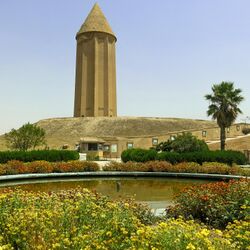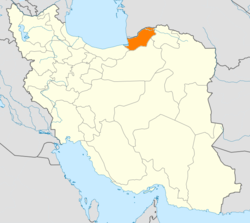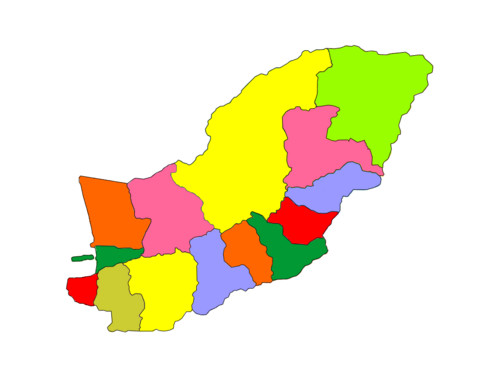محافظة گلستان
محافظة گلستان
استان گلستان | |
|---|---|
 | |
 موقع گلستان في إيران | |
| الإحداثيات: 37°20′N 55°09′E / 37.333°N 55.150°E[2] | |
| البلد | |
| المنطقة | المنطقة 1 [1] |
| العاصمة | گرگان |
| المقاطعات | 12 |
| المساحة | |
| • الإجمالي | 20٬367 كم² (7٬864 ميل²) |
| التعداد (2006)[4] | |
| • الإجمالي | 1٬617٬087 |
| • الكثافة | 79/km2 (210/sq mi) |
| منطقة التوقيت | UTC+03:30 (IRST) |
| • الصيف (التوقيت الصيفي) | UTC+04:30 (IRST) |
| اللغات الرئيسية | التركمانية مازندراني الفارسية بلوشي[5] |
گلستان هي إحدى محافظات إيران الإحدى وثلاثين، وتقع في شمال شرق البلاد وجنوب شرق بحر قزوين. Its capital is the city of Gorgan,[6] formerly called Esterabad until 1937. Golestan was split off from Mazandaran Province in 1997.
The province was made a part of Region 1 upon the division of the provinces into 5 regions, solely for coordination and development purposes, on 22 June 2014.[7] Majority of its population are Sunni Muslims.[8][9]
At the time of the 2006 National Census, the province's population was 1,593,055 in 379,354 households.[10] The following census in 2011 showed an increase in population to 1,777,014 in 482,842 households.[11] At the most recent census conducted in 2016, the population had risen to 1,868,819 in 550,249 households.[12]
. . . . . . . . . . . . . . . . . . . . . . . . . . . . . . . . . . . . . . . . . . . . . . . . . . . . . . . . . . . . . . . . . . . . . . . . . . . . . . . . . . . . . . . . . . . . . . . . . . . . . . . . . . . . . . . . . . . . . . . . . . . . . . . . . . . . . . . . . . . . . . . . . . . . . . . . . . . . . . . . . . . . . . . .
أصل الاسم
Gulistan, Golestan, or Golastan translates to "gul-" meaning "flower" and "-stan" meaning "land" or "region." Golestan, therefore, literally means "land of flowers" in Iranian languages (e.g., Persian, Kurdish, and Mazandarani). This is a common toponym in countries with Persian linguistic roots (see Gulistan).
The capital of Gorgan derives its name from a wider region known historically as Gorgân (گرگان), Middle Persian Gurgān, and Old Persian Varkāna (in the Behistun Inscription) meaning "land of wolves".[13] This is also the root of the Ancient Greek Ὑρκανία (Hyrkanía) and Latin Hyrcania. Wild wolves are still found in Golestan.
التاريخ
Human settlements in this area date back to 10,000 BC. Evidence of the ancient city of Jorjan can still be seen near the current city of Gonbad-e Kavus. It was an important city of Persia located on the Silk Road.
Under the Achaemenid Iran, it seems to have been administered as a sub-province of Parthia and is not named separately in the provincial lists of Darius and Xerxes. The Hyrcanians, however, under the leadership of Megapanus, are mentioned by Herodotus[14] in his list of Xerxes' army during the invasion of Greece.[13]
التقسيمات الإدارية
The population history and structural changes of Golestan Province's administrative divisions over three consecutive censuses are shown in the following table.
| المقاطعات | 2006[10] | 2011[11] | 2016[12] |
|---|---|---|---|
| Aliabad | 123,923 | 132,757 | 140,709 |
| Aqqala | 109,440 | 124,185 | 132,733 |
| Azadshahr | 88,251 | 91,767 | 96,803 |
| Bandar-e Gaz | 46,179 | 46,315 | 46,130 |
| Galikash[أ] | — | 59,975 | 63,173 |
| Gomishan[ب] | — | 63,447 | 68,773 |
| Gonbad-e Kavus | 283,331 | 325,789 | 348,744 |
| Gorgan | 393,887 | 462,455 | 480,541 |
| Kalaleh | 149,857 | 110,473 | 117,319 |
| Kordkuy | 67,427 | 70,244 | 71,270 |
| Maraveh Tappeh[ت] | — | 55,821 | 60,953 |
| Minudasht | 126,676 | 75,659 | 75,483 |
| Ramian | 81,866 | 85,324 | 86,210 |
| Torkaman | 122,218 | 72,803 | 79,978 |
| الإجمالي | 1,593,055 | 1,777,014 | 1,868,819 |
المدن
According to the 2016 census, 1,015,774 people (over 54% of the population of Golestan Province) live in the following cities:[12]
| City | التعداد |
|---|---|
| Aliabad-e Katul | 52,838 |
| Anbar Olum | 7,003 |
| Aqqala | 35,116 |
| Azadshahr | 43,760 |
| Bandar Torkaman | 53,970 |
| Bandar-e Gaz | 20,742 |
| Daland | 20,754 |
| Faraghi | 5,777 |
| Fazelabad | 19,461 |
| Galikash | 23,394 |
| Gomishan | 19,191 |
| Gonbad-e Kavus | 151,910 |
| Gorgan | 350,676 |
| Incheh Borun | 2,494 |
| Jelin | 7,417 |
| Kalaleh | 36,176 |
| Khan Bebin | 10,878 |
| Kordkuy | 39,881 |
| Maraveh Tappeh | 8,671 |
| Mazraeh | 4,009 |
| Minudasht | 30,085 |
| Neginshahr | 8,138 |
| Now Deh Khanduz | 2,989 |
| Now Kandeh | 6,650 |
| Ramian | 12,426 |
| Sangdevin | 4,203 |
| Sarkhon Kalateh | 7,589 |
| Siminshahr | 17,205 |
| Tatar-e Olya | 4,782 |
السكان
In 2006, the Ministry of Education of Iran estimated the ethnic breakdown of the province to be:
- Turkmens: 34.20%
- Mazandaranis: 30.40%[18][19][20]
- Sistanis & Persians: 14.90%
- Baluchis: 10.90%
- Qizilbash: 7.30%
- Others (including Azeris, Kazakhs, Kurds, Armenians and Georgians): 2.3%
The Mazandaranis who inhabit the foothills to Shah Pasand were subsumed under the rubric "Persian" by these official statistics.
The Persians/Mazandaranis are considered by nearly all inhabitants of the province to be "the old natives" while all others are considered ethnic immigrants in the past.
Most Mazandaranis live in Gorgan, Ali Abad, Kordkuy, Bandar-e Gaz and Gonbad-e Kavus. They speak Mazanderani language.[19][21][18][20][22]
The Turkmens reside in the north of the province, a plain called Turkmen Sahra. Since the 15th century, these formerly nomadic people have lived in this area, the main cities of which are Gonbad-e Kavus and Bandar Torkaman. Turkmens are Sunni Muslim. They form a sizable minority in cities such as Gorgan, Ali Abad, Kalaleh, and many eastern townships.
Azeris and the Qizilbash predate the Turkmen by centuries and have in time become completely Shia, and therefore, culturally associated with the Persians and other Shias.
The Sistani Persians and the Baluch are relatively recent arrivals and date back to the early 20th century. They are still arriving in the area in some numbers due to the lasting drought in their home areas of Sistan.
The people of Kordkuy are originally from the Kurdish areas of west Iran, Kermanshah and Kurdistan provinces. They belong to the Kord-rostami tribe and are also found in significant numbers in other cities like Gorgan and Bandare Gaz. Subtribes of the Kord-Rostami tribe are the Aghili and Sepanlou tribes.
Other ethnic groups such as Kazakhs, Khorasani Kurds, Georgians, and Armenians also reside in this area, and have preserved their traditions and rituals.
A small minority of followers of the Baháʼí faith also live in Golestan (in Shahpasand).[5][23][24]
الثقافة
The world's tallest brick structure of its kind, the Gonbad-e Qabus tower, stands in this province.
المناخ والجغرافيا
Golestan enjoys mild weather and a temperate climate most of the year. Geographically, it is divided into two sections: The plains, and the mountains of the Alborz range. In the eastern Alborz section, the direction of the mountains faces northeast and gradually decreases in height. The highest point of the province is Shavar, with a height of 3,945 meters. Two of the main rivers are the Gharasu and Gorganrud.
. . . . . . . . . . . . . . . . . . . . . . . . . . . . . . . . . . . . . . . . . . . . . . . . . . . . . . . . . . . . . . . . . . . . . . . . . . . . . . . . . . . . . . . . . . . . . . . . . . . . . . . . . . . . . . . . . . . . . . . . . . . . . . . . . . . . . . . . . . . . . . . . . . . . . . . . . . . . . . . . . . . . . . . .
Golestan National Park
Golestan National Park in northern Iran is faced with the construction of a road through the forest, allegedly for the ease of traffic for the villagers and woodmen but at the expense of losing the only national park in Iran throughout which a range of different climates (humidity near the Caspian Sea and desert farther south) is spread.
Golestan National Park is Iran's biggest national park which spans three provinces, Golestan, Mazandaran, and North Khorasan. Surprisingly, the authorities ignore repeated calls by experts to construct such roads around, instead of through, the forests, which in this way would no longer threaten animal and plant life.
الكليات والجامعات
- Golestan University
- Golestan University of Medical Sciences[25]
- Gonbad Kavous University
- Gorgan University of Agricultural Sciences and Natural Resources
- Islamic Azad University of Azadshahr
- Islamic Azad University of Gorgan
- Islamic Azad University of Ali Abad katool[26]
ملاحظات
- ^ Separated from Minudasht County[15]
- ^ Separated from Torkaman County[16]
- ^ Separated from Kalaleh County[17]
الهامش
- ^ همشهری آنلاین-استانهای کشور به ۵ منطقه تقسیم شدند
- ^ OpenStreetMap contributors (22 May 2024). "Golestan Province" (Map). OpenStreetMap. Retrieved 22 May 2024.
- ^ [1] Iranian Statistical Yearbook 1385
- ^ [2] National Census 2006
- ^ أ ب http://hamshahrionline.ir/details/17765 خطأ استشهاد: وسم
<ref>غير صالح؛ الاسم "hamshahrionline.ir" معرف أكثر من مرة بمحتويات مختلفة. - ^ "Golestan Province establishment law". Lamtakam (in الفارسية). Guardian Council. 16 September 1376. Archived from the original on 14 February 2024. Retrieved 14 February 2024.
- ^ خطأ استشهاد: وسم
<ref>غير صحيح؛ لا نص تم توفيره للمراجع المسماةReferenceA - ^ سال, سایت خبری تحلیلی شعار. "اقوام ساکن در استان گلستان". fa.
- ^ "Golestan". iranrahno.com. Retrieved 19 March 2018.
- ^ أ ب "Census of the Islamic Republic of Iran, 1385 (2006)". AMAR (in الفارسية). The Statistical Center of Iran. p. 27. Archived from the original (Excel) on 20 September 2011. Retrieved 25 September 2022.
- ^ أ ب "Census of the Islamic Republic of Iran, 1390 (2011)". Syracuse University (in الفارسية). The Statistical Center of Iran. p. 27. Archived from the original (Excel) on 17 January 2023. Retrieved 19 December 2022.
- ^ أ ب ت "Census of the Islamic Republic of Iran, 1395 (2016)". AMAR (in الفارسية). The Statistical Center of Iran. p. 27. Archived from the original (Excel) on 29 March 2019. Retrieved 19 December 2022.
- ^ أ ب "Gorgān". Encyclopaedia Iranica. Retrieved 23 December 2009.
- ^ Herodotus, Histories, 7.62
- ^ "Introduction of Galikash County". Galikesh (in الفارسية). Revolutionary Guard Corps, Gonbad-e Kavus County. Archived from the original on 30 November 2020. Retrieved 9 April 2024.
- ^ Davodi, Parviz (23 January 1388). "Approval letter regarding country divisions in Torkaman County". Lamtakam (in الفارسية). Ministry of Interior, Council of Ministers. Archived from the original on 13 February 2024. Retrieved 13 February 2024.
- ^ Davodi, Parviz (18 September 2016). "Letter of approval regarding the reforms of country divisions in Golestan province". Research Center of the System of Laws of the Islamic Council of the Farabi Library (in الفارسية). Ministry of Interior, Political-Defense Commission. Archived from the original on 23 November 2013. Retrieved 19 November 2023.
- ^ أ ب "زبان تبری". ahouraa.ir. Archived from the original on 11 October 2017. Retrieved 28 September 2018.
- ^ أ ب "GORGĀNI DIALECT – Encyclopaedia Iranica". www.iranicaonline.org.
- ^ أ ب میردیلمی، سیدضیاء، تاریخ کتول، ناشر مؤلف، ص ۲۸ و ۲۱.
- ^ احسن التّقاسیم فی معرفة الاقالیم، ص ۳۶۸
- ^ واژهنامه بزرگ تبری، گروه پدید آورندگان به سرپرستی: جهانگیر نصراشرفی و حیسن صمدی، سال 1377، جلد اول، ص 31
- ^ "Shodhganga : a reservoir of Indian theses @ INFLIBNET" (PDF). Retrieved 9 June 2023.
- ^ The Geography of Golestan Province, Educational Ministry of Iran, 2006
- ^ "Archived copy". Archived from the original on 21 March 2021. Retrieved 19 October 2005.
{{cite web}}: CS1 maint: archived copy as title (link) - ^ "Home". aliabadiau.ac.ir.



